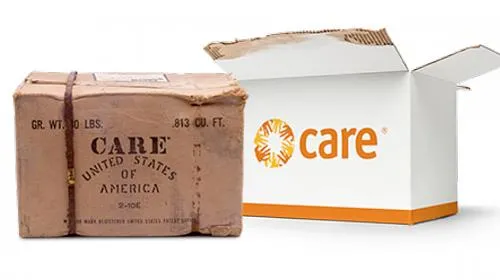ATLANTA (May 3, 2016) — A new online survey conducted by Harris Poll for the humanitarian organization CARE reveals that while 84 percent of Americans have heard of the term “care package” and 60 percent have either sent or received one, only 13 percent know where the phrase originated.
Founded to deliver those original CARE Packages of food and supplies to families clinging to survival in Europe after World War II, CARE commissioned the poll of more than 2,100 American adults in March to commemorate the 70th anniversary of those first CARE Packages. On May 11, 1946, those early cardboard boxes were distributed in Le Havre, France, the first of more than 100 million CARE Packages that Americans sent to people in need around the world.
Seven decades later, the phrase “care package” is firmly fixed in the American lexicon and seen in an overwhelmingly favorable light, with 92 percent of Americans wishing to receive one and a full 98 percent saying they would like to send one, the poll found.
“This survey shows that care packages continue to embody the best instincts of everyday Americans toward someone in need, whether they be family and friends or refugees half way around the world,” said Michelle Nunn, president and CEO of CARE. “We believe it’s important to reflect on the roots of the phrase and that unique chapter in American generosity that began in the aftermath of World War II, because the world once again is beset by massive humanitarian crises, from conflict in Syria and Yemen to hunger in Ethiopia, Somalia and southern Africa.”
When asked what meanings “care package” carries for them, more than three-quarters of Americans who knew the term (76 percent) selected “basic necessities for someone in need,” followed by “something that shows you care,” chosen by more than half (58 percent) .
The poll found some disconnects between senders and receivers, however. Those who are currently students said they most wanted to receive homemade food such as baked goods (72 percent) and gift cards (65 percent) in a care package , but when looking at what students actually received, the most common contents were snacks/candy (36 percent) and practical items (28 percent). Mother’s Day shoppers might want to peek at the survey, too as moms with kids under 18 cited different preferences for items they’d want to receive in a care package. Hint: fewer practical items for mom (49 percent), more pamper items such as fuzzy socks and body lotion (66 percent).
Among the survey’s many other findings:
- Americans would most want to send a care package to someone in the military (58 percent); a poor person in need (55 percent) and disabled veterans (49 percent).
- Millennials ages 18-34 were more likely to say they’ve ever heard of the term “care package” compared to those ages 45+ (89 percent vs. 81 percent). Millennials are also more likely than any other age group to say they love them (47 percent vs. 35 percent of those ages 35-44, 28 percent of those ages 45-54, 22 percent of those ages 55-64, and 19 percent of those ages 65+).
- Millennials ages 18 to 34 were also by far the most likely group to want to send a care package to a refugee (43 percent vs. 28 percent of those ages 35-44, 24 percent of those ages 45-54, 16 percent of those ages 55-64, and 21 percent of those ages 65+).
- Among those who have received a care package, snacks/candy was the most common contents category (64 percent), followed by homemade food (58 percent) and practical items (40 percent) such as tissues, pens and lip balm.
About CARE:
Founded in 1945 with the creation of the CARE Package®, CARE is a leading humanitarian organization fighting global poverty. CARE places special focus on working alongside women and girls because, equipped with the proper resources, they have the power to lift whole families and entire communities out of poverty. That’s why women and girls are at the heart of CARE’s community-based efforts to improve education and health, create economic opportunity, respond to emergencies and confront hunger. Last year CARE worked in 95 countries and reached more than 65 million people around the world. To learn more, visit www.care.org.
About the survey:
This survey was conducted online within the United States by Harris Poll on behalf of CARE from March 23-28, 2016 among 2,120 adults ages 18 and older. This online survey is not based on a probability sample and therefore no estimate of theoretical sampling error can be calculated. For complete survey methodology, including weighting variables, please contact Brian Feagans at bfeagans@care.org or 404-979-9453.
Media Contacts:
Nicole Harris, nharris@care.org, 404-735-0871; Brian Feagans, bfeagans@care.org or 404-979-9453.

